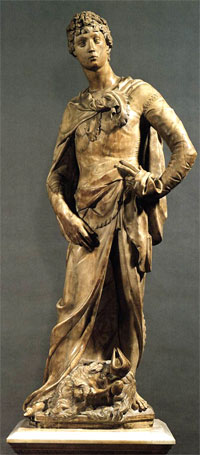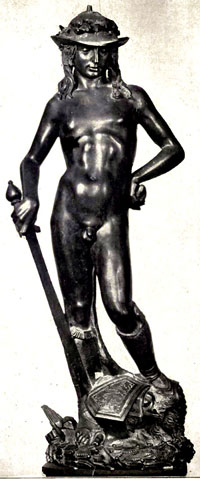David
David, the Biblical hero who fought and defeated Goliath, is the subject of two of the most appreciated sculptures created by Donatello, one executed in marble, the other one in bronze.
David history
The year of the marble David commission is uncertain. It is possible that the statue was commissioned by the Opera del Duomo, as it was executed in its workshops. In July 1416 the sculpture was taken to the Palazzo della Signoria and placed in the Sala dell' Oriolo, where it remained until the 19th century.
The creation date of the bronze David is surrounded by controversy. Some art historians are placing the date of its creation around 1430 or even earlier. Others are considering a date close to 1440, much later after Donatello returned from his second journey to Rome in 1433.

Donatello - The Marble Statue of David
Museo Nationale del Bargello, Florence
It is a real possibility that it was executed quite soon after the artist visited the city, since it shows a certain realist treatment, but also a strong impression of classical sculpture.
According to Vasari, the statue was executed for Cosimo il Vecchio, who wanted the sculpture to be in the Cortile of the Palazzo Medici. As mentioned by Landucci in his diary, it was taken to the Signoria on the 9th of December, 1495, after the expulsion of Piero di Lorenzo. In 1555 the sculpture was removed to make way for the “Putto with the Dolphin” by Verrocchio, and was placed temporarily in a niche in the same cortile. In 1777 it was in the Guardaroba of the Grand Duke. From here it was taken first to the Uffizi, and later to the Bargello.
The marble David
The marble “David” should be seen in a natural connection with St. George, though was probably created earlier. Apparently, the same youth has posed for both, the artistic difference being that the first pose is idealized, while the second one is more realistic. The sculpture was executed between 1408 – 1409, and the age of the boy seems to confirm this, as he looks a few years younger.
Technically, the sculpture has the same qualities and the same slight defects as the St. George, and is in no way inferior. The pose is supple and expressive. The neck is more refined than in previous sculptures inspired by the same ideal, and the face is softened.
David is wearing a soft leather jerkin and hose, and the modeling of the body and limbs beneath is admirable. The hands, again, are large, conventional, and roughly carved.
The pose, not exaggerated like in the warrior "Joshua," is a charming expression of early youth suppleness. After his victory over Goliath, David does not have a triumphant air, but rather one of ingenuous pleasure, combined with a sort of boyish modesty.
The only classic element is the wreath of leaves across the brow, otherwise this David is Donatello’s own, with no influence of early Italian tradition.

Donatello - The Bronze David
Museo Nationale del Bargello, Florence
The bronze David
Donatello’s bronze David, now in the Bargello, is probably more famous than its marble counterpart.
The statue has much in common with the classical Antiquity. It looks like Donatello created the sculpture solely for the beauty of form, apparently with no intention of dramatic effect.
David stands on a circular garland, one foot on the head of Goliath, sword in one hand and a stone in the other. He looks agile and supple, with a hand which is big relative to the forearm. The back is bony and rather angular; the torso is brilliantly wrought, with a purity of outline. The limbs are full of young strength, and the face is clear cut. The expression is one of dreamy contemplation as he looks downwards on the proof of his conquest.
However, the hands hold the sword and stone merely as attributes, the face is almost impersonal, and the statue seems rather typical of a rustic youth than a definite personage.
Donatello was tremendously skilled in suggesting character and emotion, however in this case the figure lacks both. The sculpture reflects a submission to the classic, overall less satisfactory than the “Annunciation.”
David is wearing his helmet, a sort of broad-brimmed hat garlanded with bay leaves, which throws the face into deep shadow. In suggesting the hot sun beating down on the mountains, and the shepherd life, this is certainly an element which adds much romantic charm to Donatello’s sculpture.
Goliath’s winged helmet, and David’s greaves are exquisitely decorated. On the helmet is carved an elaborate scene representing Cupid and Pysche drawn in a chariot by the Loves. The embellishment is prudently contained within its space, proof that Donatello would not allow the accessory to invade the statue itself, a chief fault of Verrochio’s David.
The sculpture was designed to be viewed from every point. We can imagine the statue in the center of a courtyard, and the charming effect with the sun beating down on the garlanded hat throwing the face into shadow and gleaming on the polished bronze.
Condivi mentions the statue being present in the centre of the cortile of the Signoria in 1553. On this occasion, he also made his critique of Donatello’s works, saying that the artist never had the patience to polish his works properly so that they look admirable only from a distance.
How strange this may sound when the statue is of a such a high quality, well chiseled and highly finished.
The bronze David is one of the most popular of Donatello’s sculptures. Although based on empirical knowledge, the statue of David is a consistent study in anatomy. The work was certainly a remarkable innovation, being probably the first nude statue made in Italy for a thousand years.
Donatello: Life and sculptures